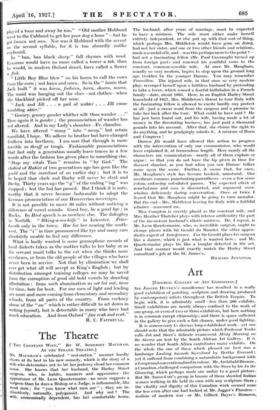Art
[IMPERIAL GALLERY OF ART EXHIBITION.] Sin JOSEPH DUVEEN'S munificence has resulted in a really good exhibition of painting, sculpture and drawing produced by contemporary artists throughout the British Empire. To begin with, it is admirably small—less than 200 exhibits. Small exhibitions are nearly always confined to the work of one group, or even of two or three exhibitors, but here nothing is in common except citizenship ; and there is space sufficient in the gallery to give each a fair chance, under good lighting.
It is unnecessary to discuss long-established work—yet one should note that the admirable picture which Professor Tonks calls Job and Steer's delicate evanescent Misty Morning on the Severn are lent by the South African Art Gallery. It is no wonder that South Africa contributes many exhibits. On the whole the one of these which pleased me best was a landscape Looking towards Swaziland by Bertha Everard ; yet it suffered from combining a naturalistic background with a foreground conventionalized in colour. Mr. Archibald Browne, a Canadian, challenged comparison with the Steer by his In the Gloaming, which perhaps made one unfair to a good picture. But Mr. Suzor-Cote's group in bronze of those shawled Indian women walking in file held its own with any sculpture there ; the vitality and dignity of this Canadian work seemed none the less even after one had looked at Mr. Jagger's Flanders- tealiim of modern' War—Or Mr. Gilbert • Bayes's Romance,
mediaeval knights three abreast, beautifully finished work in beautifully dyed marble yet strong and massive.
Two adorable pieces of small sculpture, are Italian Madonna, by Mr. James Woodford, quaint, almost bell-shaped, but so gracious and caressing in its lines and the cuddled up baby all tucked into the curve ; and Mr. John Skeaping's Roe Deer lying down with the supple neck doubled back along the body.
Mr. Stanley Spencer has a landscape, just a field with a few bushes dotted about apparently anyhow, under a dull grey sky ; but it makes everything else near it look artificial and lamplit.
Nobody who goes to this show, which will be open for three months, should miss Mr. Eric Gill's self portrait on the stairs= so skilful, so humorous a pencil drawing. Mr. Colin Gill's Leda in the main gallery is masterly ; this nude figure, relieved against the great black swan, seems so simple in drawing, yet is so subtle both in design and colour.
Perhaps the special interest of this exhibition is the very full representation of artists working in the Irish Free State. Mr. John Keating's Brethren of the Coast, a study of two Aran boatmen (Synge's people), faces straight down the room, and suggests at once the Spanish grace and the untamed wildness of Aran's people. Next it hangs a Paul Henry, Potato Diggers, thoroughly characteristic of this artist, probably the best painter Ireland has ever produced. His wife, Grace Henry, on the other hand, shows The Girl in White, work by no means characteristic of her present ultra modern manner; but only the finest colour sense rendered possible that rendering of white muslin, sitting on white brocade, relieved against white woodwork. London has seen the Henrys' work before ; but Margaret Clarke's is probably new to most people and her study in oils of an Irish girl Anne, and her chalk drawing Juliana, are two of the very best things shown. Her husband, Mr. Harry Clarke, exhibits one of his macabre studies in black and white, but Mr. Clarke's real medium is stained glass. Mr. Leo Whelan has a well-painted picture of a room with a girl standing in the light from a window, and Mr. Tuohy sends a study of a Mayo boy dressed, as the usage is, in a discarded red flannel petticoat. He has also a chalk study of Mr. Sean O'Casey. Lastly, " A. E. " sends one of his misty mountain pictures. It is a great day for Ireland.
LEMON GREY.



































 Previous page
Previous page